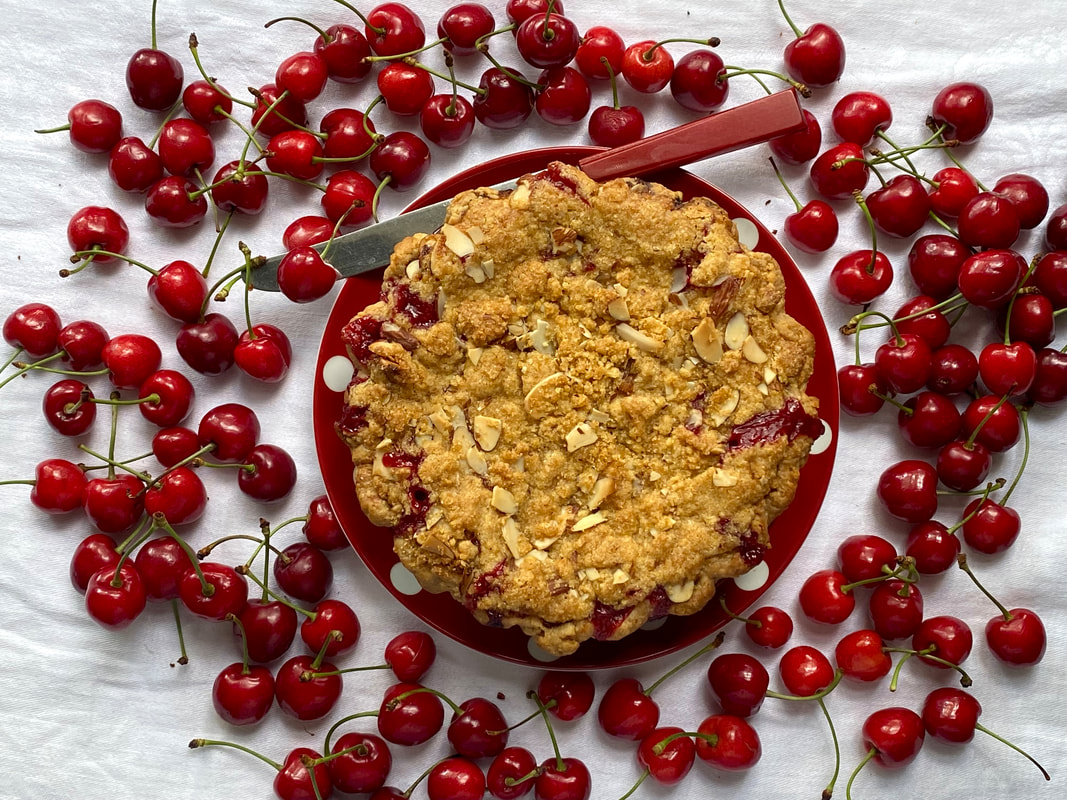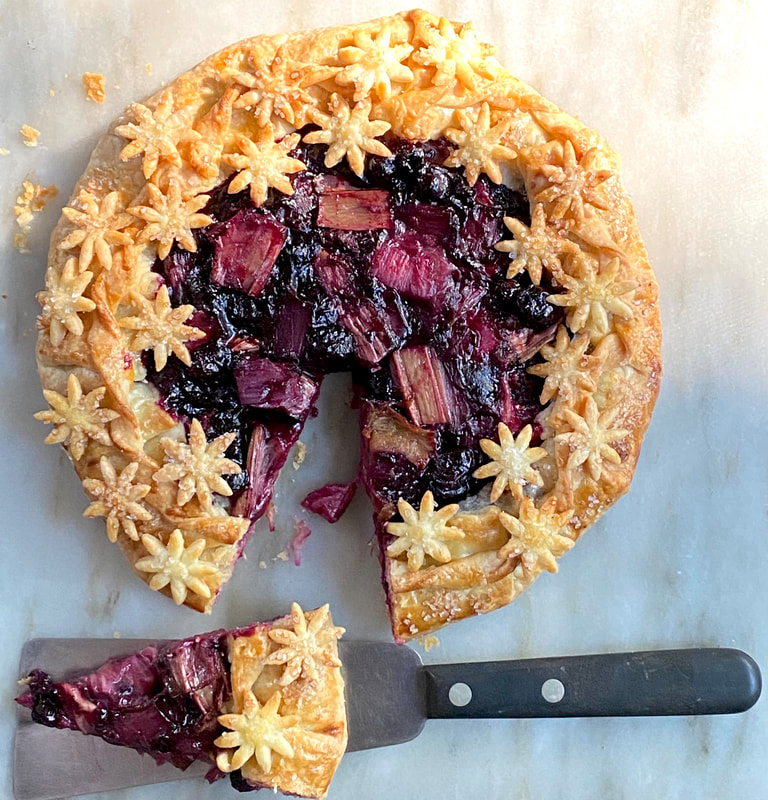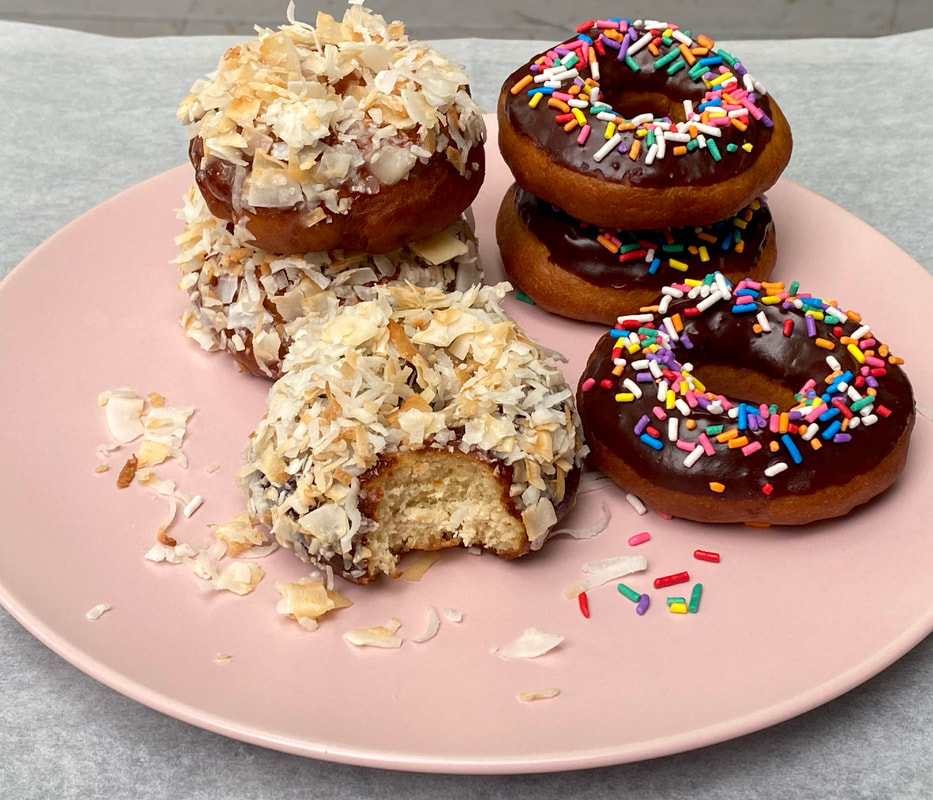|
For anyone smitten with sour cherries, chasing them from farm stands to farmers’ markets, the chase comes with the understanding that fresh sour cherries require a commitment. The crimson stone fruit with a cult following and an all-too-brief season sparkles like gemstones in the sun. Secured in your market tote and transferred to your kitchen counter, their exquisite flavor comes with a price; sour cherries certainly don’t pit themselves.
I’ve heard about (but never participated in) what is known as a cherry pitting party. My understanding is that enthusiastic bakers take a seat around a perfectly restored farmhouse table, sip tall glasses of icy Rosé, share pie stories, while effortlessly removing stems and pits. (I imagine an awful lot of white linen and red/white gingham featured in those gatherings.) My cherry pitting reality is a little more jarring, with a soundtrack taken directly from Law and Order SVU, and a countertop as pristine as a crime scene. The more I try to contain the indelible cherries, the more they ricochet from cherry pitter to just shy of the Pyrex mixing bowl. Sitting never occurs to me because I believe standing and pitting demonstrates a “let’s get this done” attitude. This could potentially accelerate the task, ushering the cherries into the pie shell with greater speed and efficiency. As a rule, I like the traditional look and the craftiness of a woven lattice-topped cherry pie. Recently however, I’ve been tossing generous handfuls of brown sugar/cornmeal/almond crumb over the cherries. One of the tastiest recipes comes from @petraparedez and if you’re not too exhausted after pitting all those cherries, making a big batch of crumb makes sense; the excess stores easily in a Ziploc in the freezer. And when cherry season is over, and it will be sooner than later, you can contact my pals @hyline orchardfarmmarket in Door County, Wisconsin and they’ll ship them to you, nicely pitted and rarin’ to go.
1 Comment
Despite Rhubarb’s nonchalance, his reaction to the over-filled mesh strainer of blueberries is ripe with disdain. “Isn’t it a touch early in the season for blueberry pie?
“Not really,” I reply without looking up from Ottolenghi’s brilliant dessert collection, Sweet. “Ooooo, maybe this…” I hold up the glossy photo of a blueberry and rhubarb galette. Rhubarb yawns. Rhubarb and I have arrived at that mid-season juncture where he knows I’m a little restless, focusing on the next best taste of summer. Far less threatened by a windfall of local strawberries, the tart vegetable has learned to respect his cohort in pie, considering the two of them simpatico. When blueberries, raspberries, and particularly peaches, inch their way toward the spotlight, Rhubarb tends to get his leaves in a snit. Trying to explain to the candy striped vegetable that he shares something in common with the indigo berry falls on deaf ears. “The two of you belong together!” I exclaim. “You’re both jam-packed with antioxidants. And,” I continue, waving the strainer of blueberries under cold water, “this galette requires very little fuss.” Rhubarb sneers. “Fuss? You mean all those ridiculous pastry cut-outs stashed in the freezer? What are they supposed to represent, exactly? Don’t you have better things to do with your post-pandemic days than cut little flowers out of pate brisee?” He does have a point. I continue. “You should be excited to spend time with someone other than Strawberry. Listen, I’m a huge fan of the two of you together, but after a while, the pairing becomes a bit, you know, pedestrian. Haven’t you noticed that blueberries complement your ruddy complexion?” Rhubarb replies quietly, “Strawberry is the Harriet to my Ozzie. Why must you ruin a good thing?” I decide to start the galette party without the pie plant. Ottolenghi’s recipe calls for crushed Amaretti cookies, but I’m forced to substitute Savoiardi biscuits and almonds. Rhubarb is familiar with the recipe, belaboring the obvious. “You’re not even following the recipe! It specifically says Amaretti cookies! Savoiardi are for tiramisu. Are you making tiramisu? And shouldn’t you pre-heat the oven before you get all fixated with your non-Amaretti cookies and your little pastry cut-outs? Did you even whisk together your egg wash?” Placing the biscuits and almonds in the bowl of the food processor fitted with the blade attachment, I bite my tongue. Adjusting the oven racks and cranking up the oven to 400 degrees, I watch Rhubarb inching closer toward the open cookbook. “Do you see the title of the recipe? It clearly says Rhubarb and Blueberry Galette. Chef Ottolenghi has definitely given me top billing.” Looking up from the butcher block table where I'm shaping a circle of pastry into a 12” round, I ask the sassy vegetable, “Does this mean you’re willing to participate?” Rhubarb shrugs. “There’s more of me in a zip-loc bag in the freezer. Just one thing…” the pie plant adds. “When you get to the part where you pleat the pastry and you attach those ridiculous pastry flowers, I’d prefer you place them closer to the blueberries. I’m allergic to flowers not found in nature.” Whisking together an egg with a little water and a pinch of salt, I nod. “Understood.” Here’s the skinny on today’s celebration. We are drawn to circles of fried dough like sprinkles to chocolate glaze. Doughnuts arrived in New Amsterdam (before it was Manhattan) and were dubbed ‘olykoeks’ or “oily cakes” by the Dutch. In the mid-19th century, Elizabeth Gregory, mother of a ship captain, cobbled together a deep-fried dough spiked with nutmeg, cinnamon, and lemon. Liz placed hazelnuts (or walnuts) in the center of the dough where it tended to remain uncooked, and called them doughnuts/donuts. Captain Gregory was given credit for placing the hole in the doughnut. Various theories abound debating and debunking the ‘hole’ truth and nothing but.
During World War I, homesick American doughboys (soldiers) were served doughnuts fried up by “Donut Lassies,” female Salvation Army volunteers. During World War II, “Donut Dollies” referred to American Red Cross volunteers working overseas in clubmobiles, single decker buses outfitted with a phonograph plus coffee and doughnut making equipment. These could be considered an early version of the food truck. The first doughnut machine arrived in New York City in 1920 and is credited to Russian baker, Adolph Levitt. This technology transformed the oily cake into something light and puffy. By 1934, doughnuts were dubbed “the food hit of the Century of Progress.” Also of note, doughnuts sold in the Depression era often included words of inspiration; “As you go through life make this your goal: Watch the doughnut, not the hole.” Words to live by as you celebrate Doughnut Day. Remember to keep the oil in the fryer plenty hot and raise your coffee mug to the Doughnut Lassies and Dollies of days gone by, and all the doughnut makers standing over deep-fat fryers today. #timetomakethedoughnuts |
Archives
July 2024
Ellen GrayProfessional Pie-isms & Seasonal Sarcasm Categories |



 RSS Feed
RSS Feed